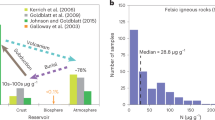Abstract
SINCE the discovery1 nearly a decade ago that Cretaceous/Tertiary (K/T) boundary layers are greatly enriched in iridium, a rare element in the Earth's crust, there has been intense controversy on the relationship between this Ir anomaly and the massive extinction of organisms ranging from dinosaurs to marine plankton that characterizes the K/T boundary. Convincing evidence suggests that both the Ir spike and the extinction event were caused by the collision of a large bolide (>10 km in diameter) with the Earth1–11. Alternative explanations claim that extensive, violent volcanism12–14 can account for the Ir, and that other independent causes were responsible for the mass extinctions15,16. We surmise that the collision of a massive extraterrestrial object with the Earth may have produced a unique organic chemical signature because certain meteorites, and probably comets, contain organic compounds which are either rare or non-existent on the Earth17. In contrast, no organic compounds would be expected to be associated with volcanic processes. Here we find that K/T boundary sediments at Stevns Klint, Denmark, contain both α-amino-isobutyric acid [AIB, (CH3)2CNH2COOH] and racemic isovaline [ISOVAL, CH3CH2(CH3)CNH2COOH], two amino acids that are exceedingly rare on the Earth but which are major amino acids in carbonaceous chondrites17,18. An extraterrestrial source is the most reasonable explanation for the presence of these amino acids.
This is a preview of subscription content, access via your institution
Access options
Subscribe to this journal
Receive 51 print issues and online access
$199.00 per year
only $3.90 per issue
Buy this article
- Purchase on Springer Link
- Instant access to full article PDF
Prices may be subject to local taxes which are calculated during checkout
Similar content being viewed by others
References
Alvarez L W et al Science 208, 1095–1108 (1980)
Sepkoski J J & Raup D M in Dynamics of Extinction (ed Elliott D K ) 3–36 (Wiley New York 1986)
Luck J M & Turekian K K Science 222, 613–615 (1983)
Kastner M et al Science 226, 137–143 (1984)
Bohor B F et al Science 224, 867–869 (1984)
Wolbach W S Lewis R S & Anders E Science 230, 167–170 (1985)
Pollack J B et al Science 219, 287–289 (1983)
Alvarez W et al Science 223, 1135–1141 (1984)
Bourgeois J et al Science 241, 567–570 (1988)
Macdougall J D Science 239, 485–487 (1988)
McHone J F et al Science 243, 1182–1184 (1989)
Officer C B & Drake C L Science 219, 1383–1390 (1983)
Officer C B & Drake C L Science 227, 1161–1167 (1985)
Hallam A Science 238, 1237–1242 (1987)
Brouwers E M et al Science 237, 1608–1610 (1987)
Padian K Clemens W A in Phanerozoic Diversity Patterns (ed Valentine J W ) 41–96 (Princeton University Press 1985)
Cronin J R Pizzarello S & Cruikshank D P in Meteorites and the Early Solar System (eds Kerridge J F & Matthews M S) 819–857 (University of Arizona Press Tucson 1988)
Kvenvolden K A Lawless J G & Ponnamperuma C Proc natn Acad Sci USA 68, 486–490 (1971)
Chapman C R Geochim cosmochim Acta 40, 701–719 (1976)
Kissel J & Krueger F R Nature 326, 755–760 (1987)
Hayatsu R & Anders E Top Curr Chem 99, 1–37 (1981)
Cronin J R & Pizzarello S Adv Space Res 3, 5–18 (1981)
Krahenbuhl, U et al. Geochim cosmochim Acta 37, 1353–1370 (1973)
Das M K Raghothama S & Balaram P Biochem 25, 7110–7117 (1986)
Pollock G E et al Geochim cosmochim Acta 39, 1571–1573 (1975)
Roach M C & Harmony M D Analyt Chem 59, 411–415 (1987)
Cheng Y F & Dovichi N J Science 242, 562–564 (1988)
Gilmour I & Anders E Geochim cosmochim Acta 53, 503–511 (1989)
Wall J S Analyt Chem 25, 950–953 (1953)
Aswad D Analyt Biochem 137, 405–409 (1984)
Nimura N & Kinoshita T J Chromatogr 352, 169–177 (1986)
Cronin J R Pizzarello S & Gandy W E Analyt Biochem 93, 174–179 (1979)
Miller S L & Bada J L Nature 334, 609–611 (1988)
Author information
Authors and Affiliations
Rights and permissions
About this article
Cite this article
Zhao, M., Bada, J. Extraterrestrial amino acids in Cretaceous/Tertiary boundary sediments at Stevns Klint, Denmark. Nature 339, 463–465 (1989). https://doi.org/10.1038/339463a0
Received:
Accepted:
Issue Date:
DOI: https://doi.org/10.1038/339463a0
Comments
By submitting a comment you agree to abide by our Terms and Community Guidelines. If you find something abusive or that does not comply with our terms or guidelines please flag it as inappropriate.



